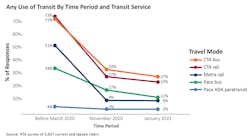Survey of Chicago region transit riders indicates potential challenges as pandemic eases
A new report from the Regional Transportation Authority (RTA) indicates that about 80 percent of transit users who stopped riding during the pandemic plan on returning to the Chicago Transit Authority (CTA), Metra and Pace if COVID-19 concerns diminish. But they also indicate telecommuting may continue at higher than pre-pandemic levels, with lasting implications for the regional transit system.
The report summarizes responses by 5,637 current and lapsed riders. In two stages during November 2020 and January 2021 — as the COVID-19 pandemic was entering a new phase with the initial advent of vaccines — the survey collected data about travel behavior, attitudes and preferences.
This is the first region-wide survey of current and lapsed transit riders since the pandemic began. The report defines “current riders” as those using transit at least once weekly. “Lapsed riders” use transit less than once weekly now but had used it at least once weekly prior to March 2020.
“A majority of current riders on all three systems feel comfortable riding because of the health precautions taken by CTA, Metra and Pace,” said RTA Executive Director Leanne Redden. “These are important insights we can use to help bring back lapsed riders who indicated they still have concerns about riding again that are based on pre-pandemic perceptions. Our challenges are substantial, but we knew they would be. This report is full of information that we and our partners will use to plan for transit’s recovery over the long term.”
By gauging lapsed riders’ willingness to resume using transit, the survey will inform planning and policies of the RTA, the Service Boards (CTA, Metra and Pace), and the Chicago Metropolitan Agency for Planning (CMAP). Since early in the pandemic, the RTA has maintained a COVID Transit Dashboard to track trends including ridership, which as of March 1, 2021, is down 71 percent compared to the pre-pandemic baseline.
The survey results confirm that telecommuting has been more common during the pandemic than before, among other research findings by RTA over the past year, including:
Significant numbers of transit riders stopped using CTA, Metra and Pace altogether during the pandemic and had not yet shown signs of returning by January 2021.
Essential on-site workers, people who identify as Black and Latino, and riders experiencing low-income have been most reliant on transit during the pandemic.
The survey also sheds light on riders’ preferences about what could drive increased transit usage. For example, speed and reliability are among their top priorities, along with improved connectivity between buses and trains across the three transit operators.
For some current and lapsed riders, anticipated future levels of telecommuting — particularly among those employed in professional services like business and finance — appeared in January to be decreasing slightly as the pandemic evolved. In contrast, telecommuting by workers in government and education actually increased from November to January, although the survey suggests this group of riders may be more likely to return to regular ridership.
While the survey indicates that automobile travel most frequently replaced pre-pandemic transit trips, the majority of transit trips are being skipped rather than replaced and car trips overall have remained steady rather than increased.
The RTA, CTA, Metra, Pace and other partners can use the survey results to enhance efforts to attract riders back to public transportation. For example:
More than half of current riders indicated satisfaction with the transit system’s COVID-19 response, and lapsed riders indicated lower approval.
Respondents indicated strong interest in additional measures to improve health and safety, including cleaner vehicles and enforcement, all of which are high priorities for the Service Boards.
Thanks to federal relief funds, critical transit services have been sustained during the pandemic, and the RTA — whose responsibility includes financing of CTA, Metra and Pace operations and capital investments — is currently in Step 2 of its three-step regional strategy for COVID-19 recovery. Starting in May, the RTA will initiate Step 3 for longer-term strategic planning through 2023 and beyond.
“The survey results foreshadow challenges we’ll address in Step 3 of the COVID recovery strategy, including how to prioritize resources,” said Jessica Hector-Hsu, RTA director of planning and market development, whose team led the survey effort. “For example, the survey gave each respondent the choice of a hypothetical investment for improving transit. Most favored investing in speed and reliability, suburb-to-suburb connections, and mobility options coordinated across CTA, Metra and Pace. Notably, lapsed riders were significantly more focused than current ones on the importance of seamless connections between CTA, Metra and Pace.”
The project was funded by the U.S. Department of Transportation through a grant from the Illinois Department of Transportation.
The complete survey is available for viewing on RTA's website.





